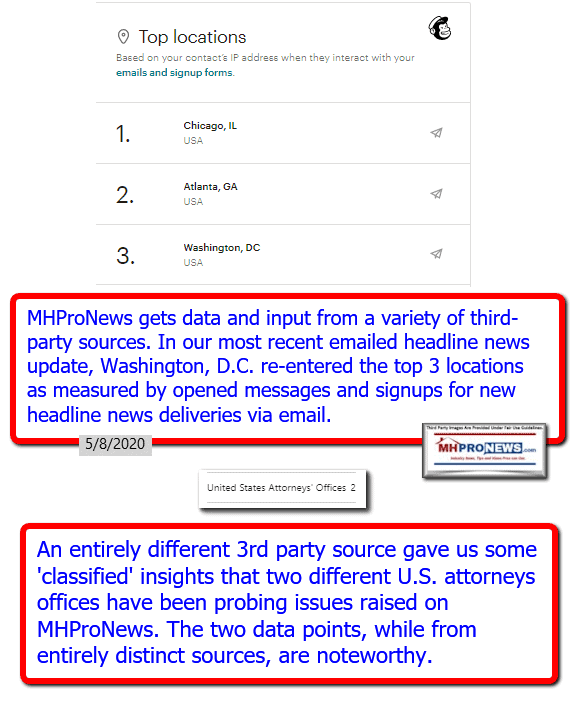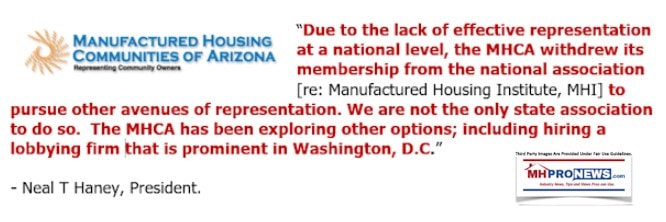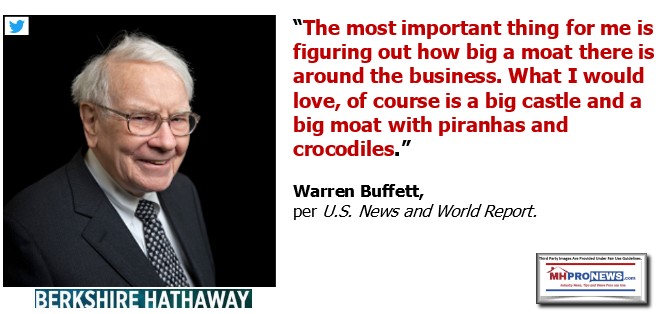Clayton Homes (BRK). Skyline Champion (SKY). Cavco Industries (CVCO). Plus the other ‘top ten’ HUD Code manufactured home builders shown below. The question of market share as it relates to manufactured housing production, finance, retail, and manufactured home land lease communities has been raised by public officials, mainstream media, various attorneys, Manufactured Home Living News, and MHProNews, among others.
While mentioning the others, this report will focus on the market share issue as it relates to production, rather than lending, retail, or communities, etc. This is an integral part of the broader topic. During an affordable housing crisis, how is it possible that manufactured housing could be functioning at such historically low levels for so many consecutive years?
“Facts are stubborn things; and whatever may be our wishes, our inclinations, or the dictates of our passion, they cannot alter the state of facts and evidence.” So said President John Adams, according to ClickonDetroit, GoodReads, and other sources. Mark Weiss, J.D., President and CEO of the Manufactured Housing Association for Regulatory Reform (MHARR) shaved that notable quote down to simply, “Facts are stubborn things.”
Presidents Adams and Weiss come from different eras, yet both made a similar and important point.
But it was “American political strategist Lee Atwater [who] said simply and succinctly: “perception is reality”” according to GroupCaliber, BrainyQuote, GoodReads, and others.
Those quotable quotes raise the questions: who are those shaping the perceived realities in our nation and profession? How are those perceptions being influenced and with what goals in mind?
Politicians and marketers – those who are ‘selling something’ – are among those who have noted that repeating false or misleading statements can often make something untrue appear to be true. In a December 14, 2017 report on MHProNews entitled Guy “Benson Demonstrates How Propaganda Works on Most Americans.” His topic was tax reform, but it applies to an array of issues including those that impact our affordable housing profession.
“We study history in order to understand the present and prepare for the future. Because anything that’s happened before can happen again.” – James Clyburn (SC-D), House Majority Whip and former history teacher. That Clyburn quote is a cautionary tale but is also a reason for hope. Clyburn said that during his celebration of the victory of his fellow Democrat and former Obama Administration Vice President Joe Biden in the Democratic primary earlier this year. Prior to that win – which Clyburn helped Biden secure by his endorsement and related efforts – Biden was losing in their presidential nomination contest to Senator Bernie Sanders (VT-I, but self-described Democratic Socialist). It all relates to the key vexing issue of “The Big Lie.” Now, Biden is that party’s presumptive nominee.

The big lie and other propaganda and manipulation techniques have been around for a long time, but it has been demonstrated here in the U.S. on numerous occasions. This quick example will make the point.
“The Big Lie has been used by members of both major parties in the U.S. “During the Republican President George W. Bush Administration, Americans were led into war against Iraq. During Democratic President Barack H. Obama’s time in the White House, the United States was led into war against Libya. In both cases, a plausible cover story was created by political leaders. Friendly or duped mainstream media produced reports favorable toward each of those administrations’ respective case for leading our nation into war.” – see the link here. Those events each occurred during our adult reader’s lifetimes.
Explaining the propaganda power of a Big Lie being repeated over and over, Wikipedia says: “The illusory truth effect (also known as the illusion of truth effect, validity effect, truth effect, or the reiteration effect) is the tendency to believe false information to be correct after repeated exposure.” That source added that “At first, the truth effect was believed to occur only when individuals are highly uncertain about a given statement.[1] Psychologists also assumed that “outlandish” headlines wouldn’t produce this effect however, recent research shows the illusory truth effect is indeed at play with false news.[5] This assumption was challenged by the results of a 2015 study by Lisa K. Fazio, Nadia M. Brasier, B. Keith Payne, and Elizabeth J. Marsh. Published in the Journal of Experimental Psychology; the study suggested that the truth effect can influence participants who actually knew the correct answer to begin with, but who were swayed to believe otherwise through the repetition of a falsehood.”
Rephrased, repeating a falsehood over and over again, the ignorant and informed alike can be persuaded to question or even change what they know or believe. In an era of widespread social media, when mainstream news is available 24/7/365 via broadcast, cable, streaming or satellite, signs and more, the opportunities to forge public opinion are pervasive.
With that foundation, let’s pivot to the headline topic.
Market Share in Manufactured Housing, Third Party Information, Fact Check and Analysis
The current data is summarized in a graphic created by MHI member and self-proclaimed “partner” MHVillage on their lightly read blog. MHProNews verified the data with a top-level source at Statistical Surveys. That noted, MHVillage has apparent errors on line 10 in the last column, when they should have shown a decline instead of an increase, based on the information shown. Their leadership team was asked earlier this morning about the apparent incorrect entries. Let’s see if they care about facts enough to correct reply and then – as needed – correct the error on their graphic? Or on their prior factually challenged reports?
That graphic should be considered in the light of the data below, which was previously confirmed by the president of Statistical Surveys. When compared to the above, a careful reading reveals that Skyline and Champion – in the last few months of 2019 – rose modestly. But Clayton Homes, Berkshire Hathaway owned and the largest company in manufactured housing by a wide margin, suddenly dipped. What explains that drop by Clayton from over 50 percent market share to just under 50 percent by year end?


It should be noted that Statistical Surveys states that they use government data. They also report on data in the RV and marine industries. As Scott Stropkai said to MHProNews, they are neutral with regard to industry or other political topics. By contrast, MHVillage has arguably had periodic problems with reporting facts, which are sometimes accurate, at other times, not. An example that the firm has not disputed is linked here, and it is one of several possible examples.
That noted, the graphic above had additional sources cited with respect to the market share data from Clayton Homes. Clayton – per the Wall Street Journal – claimed in June 20, 2019 stated the Knoxville based firm “Clayton says it sells about 42 percent of the manufactured homes in the U.S.” Clayton’s own annual report reported differently. Three different sources, two tied directly to Clayton Homes, and none of them agree on the market share facts? When asked, Clayton declined comment.
When the Wall Street Journal reporters were asked, they stood by the market share data that Clayton gave them, indicating that they only reported what Clayton claimed.
Why does market share data matter? There are several possible reasons – including, but not limited to – possible antitrust and RICO claims.


Additionally, while it isn’t the focus of this specific report, House Financial Services Committee Chair Maxine Waters previously raised the market share issue with respect to Clayton’s lending to blacks and minorities. Those points then should be viewed through a historic perspective.

Consider the information published by the now defunct Manufactured Home Merchandiser Magazine. In 2003, Clayton Homes and Oakwood Homes were number 3 and 4 out of the top 25 producers. Those top 25 producers, said the Merchandiser, had 78.8 percent market share in 2003. Fast-forward to year-end 2019, and the top 3 firms now have some 80 percent market share.
What explains that steady consolidation during an affordable housing crisis?




Manufactured Housing Institute Data and Statements – the Good, Bad, and Ugly
Let’s be as clear as possible. Some things that the Manufactured Housing Institute (MHI) state are true. Others are purportedly misleading or demonstrably false. When asked to clarify or correct apparent inaccuracies, MHI may go silent, double down, or reportedly reply via surrogates who get compensation or benefits for doing what they are asked to do. But if information were routinely and consistently accurate, why is there a need for posturing or maneuvering at all? If there is an honest mistake, why not simply correct the error? Rephrased, MHI’s pattern of behavior is odd at best, periodically inept, or duplicitous at worst.

Clayton Homes (BRK), Skyline-Champion (SKY), and Cavco Industries (CVCO) are members of the Manufactured Housing Institute (MHI). Each firm reportedly has the same access to government data and research by firms such as Statistical Surveys. There is no gray area with facts, or at least there shouldn’t be. Which begs the question. Why is that there are several mutually contradictory information claims about something that should be as clear as market share? Why, in this case, would SKY provide in accurate info on ‘rival’ Clayton Homes? One must keep in mind that publicly traded firms are required to provide accurate info.
In the course of their respective Investor Relations statements, Skyline Champion and Cavco Industries have each stressed that a focus for them is market consolidation.




Why would M&A – Mergers and Acquisitions – be a big priority when the general industry trend has been down since 20 year ago? Shouldn’t the greater emphasis be on growing market share, instead of pushing for more consolidation? MHI provides an antitrust warning, linked here. Is that window dressing, as is the MHI/NCC Code of Ethical Conduct?

Part of what drives these issues is access – or the lack thereof – to competitive financing. Danny Ghorbani, currently an advisor to the Manufactured Housing Association for Regulatory Reform (MHARR), but who served for decades as their founding president and CEO, lays out a step by step case on the importance of implementing the Duty To Serve manufactured housing. For new readers and a reminder to others, Ghorbani’s career began in engineering and included years as an MHI Vice President.

When Cavco Industries (CVCO) announced that they and their former president and CEO, Joe Stegmayer, had been given a subpoena in November of 2018, their stock tanked. Publicly traded firms are supposed to provide accurate information to investors.
Sources with the top 3 MHI member producers each inform MHProNews that our emailed news updates and reports are routine reading for their management. Similarly, MHI members, affiliates, and staff are routine readers – but MHI hired an outside attorney who advised MHProNews in writing that MHI were using them to monitor our website.
That’s not only a ‘red badge of courage,’ as a longtime MHI contact said to MHProNews. It is an ongoing fact check of our reports and claims. If they found errors, they would not be shy about saying so, as that outside counsel made clear.
Rephrased, there are several indicators that the market in manufactured housing is being manipulated by the largest producers of HUD Code manufactured homes.

The truth has been hiding in plain sight for years. Is someone seriously going to suggest that Berkshire Hathaway was unable to grow the manufactured housing industry? The evidence and logic are ‘in your face.’


There are numerous issues that routinely circle back to MHI’s largest members that point to various types of market manipulation that arguably aim at market consolidation. It goes beyond speculation when those involved clearly and repeatedly have made such statements.
Cavco Industries “Killer Acquisition,” CVCO’s New Controversy Tests Antitrust Resolve
Clayton Homes went from some 13 percent market share in 2003 to some 50 percent by 2018. It may be a coincidence, but as MHProNews has spotlighted those issues, the efforts to obscure the market share data seems to have grown.


While those who stand questioned may try to deflect or duck, they have themselves praised this platform for years. They did so until the fact-checks began to reveal their own apparent issues.


Programming Notice: a federal source has provided MHProNews with hundreds of pages of documents. MHProNews plans a series of reports based on those federal documents in the days ahead. Stay tuned.
As Congress, the Department of Justice (DOJ), the Federal Trade Commission (FTC) and others push on antitrust, as are certain states, and affordable housing remains a key topic nationally, these warning flags only underscore the necessity of formally investigating MHI and several of their top member firms.
MHI postured for years that they were promoting the industry. But instead of growth, 2019 witnessed a decline in manufactured housing industry shipments in 2019 vs. 2018? Years of research could be boiled down to the notion that by accident, incompetence, or design, the ‘leaders’ involved at MHI and the ‘big boy’ companies that dominate the association were fostering or allowing tepid growth or even a contraction during the affordable housing crisis.
Who benefited from this apparent pattern of activity? The largest companies, all of which are MHI members. Coincidences?

See the related reports following the byline and notices.
An attorney with long ties to MHI with no similar ties to MHARR told MHProNews recently about his view that there is ‘significant fraud and corruption evident in manufactured housing.’
The point is that the warning signs are there for those willing to look. There are known federal and state investigations for the same reasons.
The industry is underperforming. There has to be a logical reason for that during an affordable housing crisis. The reason this site is so highly read by MHPros is arguably because we gather the facts, data and provide analysis that no one else in the industry’s trade media dares publishing. That’s likely why were are the documented runaway #1 most read and largest.
That’s a wrap on this installment of manufactured housing “Industry News, Tips, and Views Pros Can Use” © where “We Provide, You Decide.” © ## (Affordable housing, manufactured homes, reports, fact-checks, analysis, and commentary. Third-party images or content are provided under fair use guidelines for media.) (See Related Reports, further below. Text/image boxes often are hot-linked to other reports that can be access by clicking on them.)

By L.A. “Tony” Kovach – for MHLivingNews.com.
Tony earned a journalism scholarship and earned numerous awards in history and in manufactured housing. For example, he earned the prestigious Lottinville Award in history from the University of Oklahoma, where he studied history and business management. He’s a managing member and co-founder of LifeStyle Factory Homes, LLC, the parent company to MHProNews, and MHLivingNews.com. This article reflects the LLC’s and/or the writer’s position, and may or may not reflect the views of sponsors or supporters.
Connect on LinkedIn: http://www.linkedin.com/in/latonykovach
Recent and Related Reports:
The text/image boxes below are linked to other reports, which can be accessed by clicking on them.







“MHI Lies, Independent Businesses Die” © – True or False? – Berkshire’s Joanne Stevens Strikes Again








































